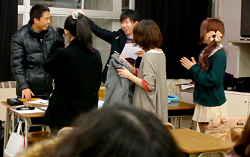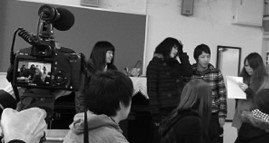Situational theorists provide some insight into how a comprehensive learning model might find and apply the practice best suited for the context and not be limited by a myopic philosophical lens. Each traditional philosophy seems to offer a different piece of reality that suggests tools and practices that can be effectively applied in most learning applications. Grow’s Staged Self-Directed Learning Model and Garner’s Multiple Intelligence Theory offer examples of how educators can match practice with the needs of learners.
Grow’s Staged Self-Directed Learning Model
Grow’s [43] Staged Self Directed Learning Model provides a framework that adapts situational leadership models from business to help teachers align classroom leadership with the abilities and motivations of the learner. The objective is to facilitate the learner toward self-direction. Scaffolding is a technique educators can use to facilitate learners toward self-direction. In scaffolding, the teacher carefully guides the student through the initial stages of learning, then gradually removes support as the student progresses toward independence [2].
SDL attempts to prepare individual students to be lifelong learners by developing capacity for self-direction, awareness of metacognitive processes, and a disposition for learning. Although individually focused, SDL environments tend to be highly collaborative. Evidence for the collaborative nature of SDL can be found in trends toward creating communities of learning and team learning environments.
While generally applied in adult learning environments, adults are hardly unique in their ability to be self-directed. Anyone who has seen a child devour books on dinosaurs, explore the biology of a backyard, or scour the Internet for cheat codes on the latest video game has seen the powerful potential of self-directed learning in a child’s life. However, as with teachers of adults, teachers of children must consider the learner's readiness before leaving learning up to the individual.
Gardner’s Multiple Intelligences Theory
Gardner [44] said that using a uniform approach to learning might seem fair by treating every individual the same. However, he argued that a universal approach is ultimately unfair because it does not meet the needs of individual learners with different needs and abilities. To Gardner, the traditional definition of intelligence is limiting because it:
- Measures an individual’s ability to answer questions on a test
- Assumes the individual’s inherent intelligence remains relatively unchanged throughout life.
A limited definition of intelligence restricts educational programs to developing learners' logical and linguistic skills while ignoring entire human ranges of ability.
Applying MI
Applying lessons learned from cognitive science and neuroscience, Gardner proposed a theory of multiple intelligences. His view sees intelligence as a “set of abilities, talents, or mental skills” [44, p. 6] that dynamically interact and develop as individuals mature. Gardner proposed that individuals have eight different intelligences that account for a broad range of capacity, as follows:
- Verbal-Linguistic Intelligence reflects the ability to communicate through language.
- Logical-Mathematical Intelligence reflects the ability to understand logic and solve problems.
- Bodily-Kinesthetic Intelligence reflects the ability to use the body skillfully and to absorb knowledge through sensation.
- Visual-Spatial Intelligence reflects the ability to understand spatial relationships and perceive and create images.
- Interpersonal Intelligence reflects the ability to relate to others, noticing their moods, motivations, and feelings.
- Intrapersonal Intelligence reflects the ability to understand one’s own behavior and feelings.
- Musical intelligence reflects the ability to comprehend and create meaningful sounds and recognize patterns.
- Naturalist Intelligence reflects the human tendency to relate information to natural surroundings.
Gardner also considered adding Existential Intelligence in recognition of the “human ability to ponder the most fundamental questions of existence” [44, p. 20].
Acknowledging individual learners’ different cognitive strengths and styles can better serve learners with an “individual-centered” instructional approach [44, p. 5]. An individual-centered approach matches methodology to the individual needs and abilities of the learners.
Gardner’s MI vision is a radical departure from traditional learning models that attempt to mold the individual to the objectives of the institution, organization, or instructor. However, a critical difference between Gardner’s vision and traditional methodologies is the necessary resources for implementing a unique program to meet individual needs rather than a single program to accommodate the objectives of the institution or society.
MI through Dynamic Skills Theory
In practice, educators use MI theory to provide developmental opportunities for all intelligences, not only those that seem to come naturally for the student. This approach can help students tap inherent gifts to develop other intelligences. Fischer’s dynamic skills theory helps to demonstrate how this works. Fischer [45] uses a developmental web as a metaphor to show how developmental change occurs on multiple parallel strands rather than through linear stages. Separate strands of the web represent an individual’s different developmental pathways. A strand can start, branch, stop, or intersect with other strands depending on the individual, context, and environment.
Applying Fisher’s dynamic skills theory to MI, a child develops different intellectual domains for language, logic and math, music, physical coordination, pattern recognition, interpersonal relations, intrapersonal relations, and natural awareness. Within each of these domains, the child constructs new skills, with each new skill represented by a new strand. Each new skill branches to form an increasingly complex skill set that may branch and connect with other strands to create an increasingly complex developmental web [46, p. 142]. In short, multiple factors continuously interact in multilevel contexts across various time scales to generate different levels of development in each domain.
For example, a person who is highly skilled at math may be moderately skilled at art. As a person matures, skills can combine to create novel skills. An individual with high Mathematical-Logical Intelligence may apply his math skills to calculate and draw angles to create a new art form. Likewise, a child with a gift for music may enhance his inherent musical ability as he develops reading skills that help him explore the stories behind the songs more deeply.
The dynamic skills framework analyzes the individual’s cognitive development as a dynamic system. Factors of varying importance continuously interact in multiple contexts that unfold over multiple time scales to create change [46].
Multiple Pathways to Learning Assessment
Joyce Bishop’s [47] Multiple Pathways to Learning Assessment is a practical tool for determining the degree to which specific intelligences developed. The purpose is to identify learning strategies that developed intelligences while building less-developed intelligences [47].
For example, an individual with high Interpersonal Intelligence may learn more effectively in a social setting to discuss information with someone else. Likewise, an individual who scores high in Intrapersonal Intelligence may learn more effectively in a solitary environment by quietly reflect on information.
Limitations of situational models
Despite making intuitive sense, critics point to numerous weaknesses in applying situational leadership in the classroom.
Individualist
Merriam [48] argued that a critical limitation of situational theories is that they have a “blinding focus on the individual learner while ignoring the socio-historical context in which [learning] occurs” [48, p. 11]. Groups rarely exhibit functional homogeneity among members; student groups are typically composed of individuals with varying degrees of skills, abilities, and motivations.
Fortunately, learning team models offer a strategy for implementing contingency approaches that meet individual student needs while aligning classroom activities to developing the needs of all students [49]. For example, in a typical team learning environment, an instructor organizes individuals into formal learning teams responsible for developing each individual and the other learning teams in a class by mutually exploring resources for solving problems. The team then contributes to developing the entire class, which contributes to developing the members of each team in the class [50]. Using an interdependent process that actively engages people at individual, group, and classroom levels actively engages groups of diverse learners in mutual development [49]. This same type of collaboration works well in helping learning organizations capture and distribute worker knowledge and experience [4].
Integrating contingency approaches with a collaborative learning model may help faculty build high-performance learning environments. They can apply “multi-gogical” [51] or integrative teaching methods that allow all students to engage in individual and collaborative learning to accelerate academic development toward self-direction. The learning team model also allows opportunities for learners to build a social network of students with similar skills. This allows faculty to deliver simultaneously personalized teaching methods to smaller groups within the classroom [49].
Dynamic needs
Another important consideration of contingency approaches in learning applications is that individual needs tend to be dynamic. Needs and motivations adjust depending on factors both internal and external to the learner [6]. For example, adult students who are self-directed in a management course may struggle to grasp a math course. This requires the math teacher to apply a more directive teaching style than the style used by the teacher in the management course. Also, the self-directed student may not have the patience to deal with the slow pace at which learning can unfold in a facilitated collaborative learning environment. The self-directed learner might want the faculty to “just get to the point rather than play games all night,” as one student expressed in a recent survey about teaching practices in a facilitated classroom [49].
Student expectations trump faculty assumptions
Taylor, Marienau, and Morris [52] offered an additional caveat for faculty who want to act as pure delegators in an adult-learning environment. Self-directed learners “may feel shortchanged when an educator explains that she intends to be less a source of answers than a resource for learning” [52, p. ch.3 para. 8]. Experienced learners may want their instructors to deliver value, not just delegate teaching to and facilitate learning among adult learners.
In short, dynamic and diverse student needs require that the instructor build a flexible leadership style and a versatile toolkit for building a dynamic learning environment in which learners can recognize value, regardless of their learning stage.





![Your brain can keep growing, adapting, and learning at any age, if you are willing to put in the effort [Image: Copilot]](/images/Images/best-years-for-adult-brain300.png)
